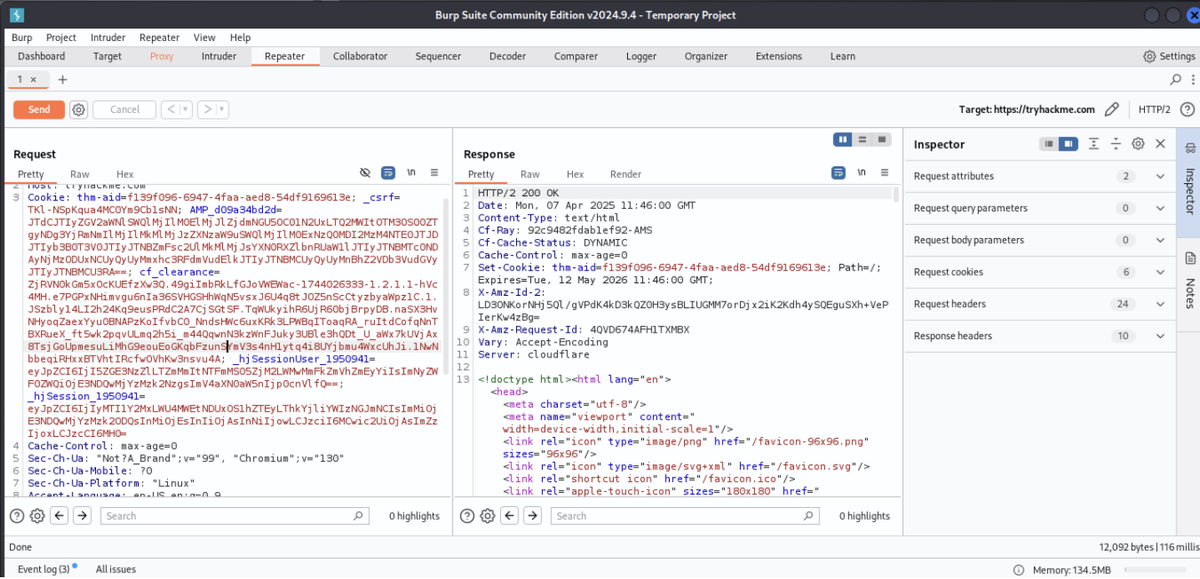Mastering Burp Suite: Web Security Testing & Real-World Exploits

Introduction
As I continue my deep dive into penetration testing and offensive security, I've been focusing on mastering Burp Suite, one of the most powerful tools for web security testing. Throughout my journey, I’ve encountered various attack scenarios, analyzed vulnerabilities, and explored the different capabilities Burp Suite offers. This tool has become a core part of my learning experience on TryHackMe, where I’m progressing through the Jr. Penetration Tester path.
In this post, I want to cover everything I’ve learned so far, including practical applications, real-world attack scenarios, and advanced security techniques. We’ll go through:
- What Burp Suite is and why it’s essential
- A step-by-step attack scenario exploiting insecure authentication
- Analyzing session security using Burp Suite Sequencer
- Using Burp Suite Comparer for hash analysis
- Lessons from my TryHackMe exercises
- How this knowledge is shaping my path into offensive security
This post is not just a technical breakdown, it’s also a personal reflection on how these skills fit into my long-term career goals. I’ve always been fascinated by how things work under the hood, and this is another piece of the puzzle in my cybersecurity journey.
Understanding Burp Suite: The Hacker’s Toolkit
Burp Suite is an all-in-one web security testing platform used by penetration testers and security researchers worldwide. It allows users to intercept, manipulate, and analyze web traffic, making it an essential tool for identifying vulnerabilities in web applications.
There are three editions of Burp Suite:
- Community Edition - Free but lacks automation and advanced features.
- Professional Edition - A paid version with powerful scanning tools and advanced automation.
- Enterprise Edition - Designed for large-scale security testing across multiple applications.
Key Features of Burp Suite
- Burp Proxy - Intercepts and modifies HTTP/S traffic between the browser and the server.
- Burp Repeater - Allows users to manually modify and resend requests.
- Burp Intruder - Automates attacks like brute force and parameter fuzzing.
- Burp Sequencer - Analyzes the randomness of session tokens.
- Burp Comparer - Compares different responses, session tokens, or hashed values.
- Burp Decoder - Helps in encoding and decoding data.
These features make Burp Suite a go-to tool for testing authentication mechanisms, manipulating session tokens, and uncovering security flaws in applications. Now, let’s put theory into practice.
Practical Scenario: Exploiting an IDOR Vulnerability
One of the most interesting attack scenarios I worked on involved Insecure Direct Object Reference (IDOR). This vulnerability occurs when an application fails to enforce proper access control on user-specific resources.
Scenario: Unauthorized Access to Support Tickets
Imagine a web-based support system where each ticket has a numerical identifier in the URL:
http://10.10.185.10/support/ticket/NUMBERIf the application lacks proper access controls, an attacker can modify the ticket number to access other users' tickets.
Step 1: Intercepting a Request
Using Burp Proxy, I captured a request while logged into my account:
GET /support/ticket/123 HTTP/1.1
Host: 10.10.185.10
Cookie: session=eyJ0b2tlbiI6IjoiMzUyNTQ5ZjgStep 2: Testing for Unauthorized Access
By modifying the ticket ID, I attempted to access another user’s ticket:
GET /support/ticket/124 HTTP/1.1If successful, this confirms an IDOR vulnerability, allowing an attacker to access sensitive user data.
Step 3: Automating with Burp Intruder
To efficiently test multiple ticket numbers, I used Burp Intruder:
- Defined the payload position at
/support/ticket/§NUMBER§ - Configured it to iterate through 1000-2000 ticket numbers
- Launched the attack and extracted unauthorized user data
IDOR vulnerabilities are dangerous because they allow attackers to access or manipulate data without proper authorization.
Analyzing Session Security with Burp Suite Sequencer
Why Session Tokens Matter
Session tokens authenticate users during web sessions. If tokens lack sufficient entropy (randomness), attackers can predict and hijack sessions.
Task: Capturing and Analyzing Tokens
- Captured session tokens from the admin login portal.
- Sent tokens to Burp Sequencer for entropy analysis.
- Evaluated the security of session generation.
Findings:
- Entropy Level: The session tokens had 117 bits of entropy, indicating high randomness.
- Reliability: A 99% confidence level suggested secure token generation.
- Sample Size: 10,539 session tokens were analyzed.
If entropy is low, an attacker can predict session IDs, gaining unauthorized access. This is why session security is critical in web applications.
Comparing Hashes & Analyzing Data with Burp Suite Comparer
Why Compare Hashes?
Attackers often analyze hash values to detect patterns or weaknesses in cryptographic storage.
Task: Identifying Weak Hashes
- Captured multiple hashed passwords from an intercepted login request.
- Used Burp Comparer to identify similar hash values.
- Detected potential weak hashing algorithms, making brute-force attacks feasible.
By identifying small variations in hashed data, attackers can crack weak encryption and retrieve original passwords.
Reflections & Next Steps
My Burp Suite training has given me a deeper understanding of web security vulnerabilities and how attackers exploit them. These skills are directly applicable to my future in offensive security.
For my next focus, I will be learning:
- Wireshark - Packet analysis and network security.
- Metasploit - Exploitation framework for penetration testing.
- John the Ripper - Advanced password cracking.
- Privilege Escalation - Gaining higher system privileges.
- Nmap - Network scanning and reconnaissance.
These tools will help me refine my skills in penetration testing, vulnerability assessment, and security research. I will continue documenting my progress and sharing my experiences as I deepen my expertise in ethical hacking.
Stay tuned for the next post, where I will focus on one of these tools in depth and share more practical insights!